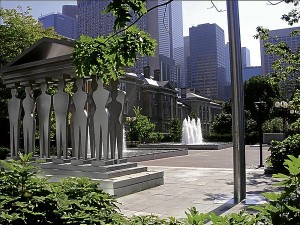Promoting a culture of walking

GOVERNMENT leadership and business community support link together Toronto’s pedestrian-related policies, guidelines, programs and services. Photo by Amado de Jesus
Melbourne has outpaced Vancouver as the most liveable city in the world, according to the Economist Intelligence Unit’s Global Liveability Survey. It was given a score of 97.5 percent after evaluating 140 cities around the world.
Cities are evaluated based on their political and social stability, crime rate and access to quality healthcare. It considers the standard of cultural events, natural environment, infrastructure and public transport.
Melbourne and other liveable cities are all walkable cities. This characteristic of liveable cities is an important measure of their health and vitality.
Many studies confirm that people living in walkable communities drive less, walk more and are less likely to end up obese and afflicted with other health problems.
One study done in New York found that men who live in the suburbs weighed 10 pounds more than their city counterparts. The suburbanite is dependent on the car to move from garage to work to grocery, whereas the New Yorker is constantly on his feet while doing the same chores. They say New Yorkers are the fastest pedestrians in the United States. People who walk faster live longer.
Compact city centers
Metro Manila, a developing mega city with a population of over 10 million, is a polycentric metropolis. We have a number of city centers characterized by residential communities, shopping malls, business districts, run-down and slum areas.
The city centers are separated and also connected by major roads and highways. Hopefully they will be joined together by an efficient mass transport system.
Otherwise, gentrification caused by high toll fees for the well-off and poorly connected congested public roads for the less privileged will deeply fragment the populace socially. The experience of advanced countries shows that building highways with high toll fees is not sustainable.
A compact city must work for social sustainability. A good transport network that is priced enough so as not to exclude the poor, and is attractive and affordable to all calls for joint public and private investment in the public good.
City safety
A walkable city must first of all be safe. The famous author Jane Jacobs wrote that once a street is well equipped to handle strangers, once it has both a good and effective demarcation between private and public spaces, and has a good supply of activity and eyes, the more strangers the merrier. Good street lighting plus street residents who give general street support with their eyes ensure city safety.
You can tell a nice city by its sidewalks. As we promote tourism in our growing cities, we can aim to provide generously spaced, secure and well-designed sidewalks for pedestrians to move about within the city.
An element needed in our cities is the curb ramp for different types of pedestrians.
A curb ramp is an inclined surface built into the curb of a sidewalk for easy access to the street, especially for bicyclists, pedestrians with baby strollers and for physically disabled people.
Walkable cities start out by acknowledging that pedestrians are at the top of the transportation hierarchy. They reallocate road space by narrowing road space and widening sidewalks. This is part of the plan adopted by Toronto in its Walking Strategy aimed at promoting a culture of walking, making their streets for pedestrians and creating spaces and places for people. It is interesting to note that the most economically successful commercial streets are those that have high levels of pedestrian traffic.
Benefits of walking
Walking is not just about getting from place to place. It provides social interaction and public participation—something that is gradually disappearing as we become more and more dependent—and addicted—to electronic communication.
One very successful concept in many countries is the Pedestrian Sunday whereby a busy street is temporarily closed to operate like an open-air mall or traditional market. Store owners bring out their merchandise into the sidewalks and pedestrians are free to stroll on the streets on Sundays.
For comments or inquiries, email amadodejesus@gmail.com
